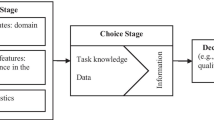Abstract
This paper develops hypotheses about the implications of different types of decision for the utilization of different types of systematically produced information: data, research, and analysis. The engineering and enlightenment models found in the knowledge utilization literature prove inadequate for this purpose. We turn to three decision models—routine, incremental, and fundamental–and determine their implied demands for information. We also examine how information might be used in scanning procedures in anticipation of decision regime shifts. The results suggest that patterns of information should differ markedly in each decision context and indicate that there may be an inherent bias against the use of research in decision.
Similar content being viewed by others
References
Allison, G.T. (1971).The essence of decision: Explaining the Cuban missile crisis. Boston: Little, Brown.
Arrow, K.J. (1974).The limits of organization. New York: Norton.
Bardach, E. (1984). The dissemination of policy research to policymakers.Knowledge, 6, 125–144.
Bulmer, M. (1987). Governments and social science: Patterns of mutual influence. In M. Blumer (Ed.),Social science research and government (pp. 1–23). Cambridge: Cambridge University Press.
Braybrooke, C.E., & Lindblom, C.E. (1963).A strategy of decision: Policy evaluation as a social process. New York: Free Press.
Caplan, N., Morrison, A. & Stambaugh, R. (1975).The use of social science know-ledge in policy decisions at the national level. Ann Arbor, MI: University of Michigan, Institute for Social Research.
Cyert, R.M., & March, J.G. (1963).A behavioral theory of the firm. Englewood Cliffs, NJ: Prentice-Hall.
Dahl, R.A., & Lindblom, C.E. (1953).Politics, economics, and welfare. New York: Harper & Row.
de Neufville, J.I. (1975).Social indicators and public policy: Interactive processes of design and applications. New York: Elsevier.
Desveaux, J.A. (1984). Comprehensive decision-making and error-correction: The Department of Energy, Mines and Resources and its implementation of the National Energy Program. Mimeo.
Desveaux, J.A. (1987).Strategy, structure, and government intervention: An organizational analysis of Canada's national energy program. Unpublished doctoral dissertation, University of California at Berkeley.
Etzioni, A. (1967). Mixed scanning: A ‘third’ approach to decision making.Public Administration Review, 27, 385–392.
Etzioni, A. (1986). Mixed scanning revisited.Public Administration Review, 46(1), 8–14.
George, A.L. (1980).Presidential decisionmaking in foreign policy: The effective use of information and advice. Boulder: Westview.
Glazer, N. (1959). The rise of social research in Europe. In D. Lerner (Ed.),The human meaning of social sciences (pp. 43–72). New York: Meridian.
Good, D.A. (1980).The politics of anticipation: Making Canadian federal tax policy. Ottawa: Carleton University, School of Public Administration.
Kingdon, J. (1984).Agendas, alternatives, and public policies. Boston: Little, Brown.
Knott, J. & Wildavsky, A. (1980). If dissemination is the solution, what is the problem?Knowledge, 1(4), 550.
Janis, I. (1972).Victims of groupthink. Boston: Houghton Mifflin.
Lindblom, C.E. (1958). Policy analysis.American Economic Review, 48, 298–312.
Lindblom, C.E. (1959). The science of ‘muddling through’.Public Administration Review, 19, 79–89.
Lindblom, C.E. (1965).The intelligence of democracy. New York: Free Press.
Lindblom, C.E., & Cohen, D.K. (1979).Usable knowledge: Social science and social problem solving. New Haven: Yale University Press.
Majchrzak, A. (1986). Information focus and data sources: When will they lead to use?Evaluation Review, 10(2), 193–215.
March, J.G., & Olsen, J.P. (1976).Ambiguity and choice in organizations. Bergen: Universitetsfolaget.
March, J.G. & Simon, H. (1958).Organizations. New York: John Wiley.
Nelson, R.R., & Winter, S.G. (1982).An evolutionary theory of economic change. Cambridge: Harvard University Press.
Popper, K. R. (1944/1985) Piecemeal social engineering. In D. Miller (Ed.),Popper selections. Princeton: Princeton University Press.
Rich, R.F. (1981).Social science information and decisionmaking. San Francisco: Jossey-Bass.
Sabatier, P.A. (1987). Knowledge, policy-oriented learning, and policy change: An advocacy coalition framework.Knowledge, 8(4), 649–692.
Steinbruner, J.D. (1974).A cybernetic theory of decision. Princeton: Princeton University Press.
Webber, D.J. (1986). Explaining policymakers' use of policy information: The relative importance of the two-community theory versus decision-maker orientation.Knowledge, 8(3), 287.
Weiss, C.H. (1977). Research for policy's sake: The enlightenment function of social research.Policy Analysis, 3(4), 531–545.
Weiss, C.H. (1980). Knowledge creep and decision accretion.Knowledge, 1(3), 381–404.
Weiss, C.H. (1981). Use of social science research in organizations: The constrained repertoire theory. In H.D. Stein (Ed.),Organizations and the human services: Cross disciplinary reflections. Philadelphia: Temple University Press.
Weiss, C.H. (1983). Ideology, interests, and information: The basis for policy positions. In D. Callahan & B. Jennings (Eds.),Ethics, the social sciences, and policy analysis (pp. 213–245). New York: Plenum Press.
Weiss, C.H. and Bucuvalas, M.J. (1980).Social science research and decisionmaking. New York: Columbia University Press.
Weiss, J.A., & Gruber, J.E. (1984). Using knowledge for control in fragmented policy arenas.Journal of Policy Analysis and Management, 3(2), 225–247.
Wildavsky, A. (1979).The politics of the budgetary process (3rd ed.). Boston: Little, Brown.
Additional information
Evert A. Lindquist, a doctoral candidate at the Graduate School of Public Policy, University of Calfornia at Berkeley, is completing a dissertation onPolicy Institutes in Canada: The Organization and Relevance of Public Inquiry and will join the faculty of the Department of Political Science at the University of Toronto this fall. Organizations, public policy, and the role of information in decision making are among his primary research interests.
Rights and permissions
About this article
Cite this article
Lindquist, E.A. What do decision models tell us about information use?. Knowledge in Society 1, 86–111 (1988). https://doi.org/10.1007/BF02687215
Issue Date:
DOI: https://doi.org/10.1007/BF02687215




